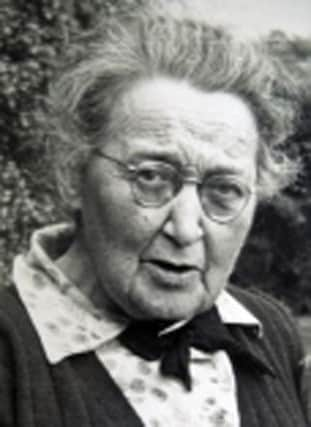Roamer: Maude Jane Delap - the natural history enthusiast


Belfast’s rarely recounted stained-glass artist Wilhelmina Geddes was mentioned on this page just before Christmas.
Almost forgotten until Dublin historian Nicola Gordon Bowe recently published her lavishly illustrated biography, Wilhelmina was described after her death in 1955 as ‘the greatest stained glass artist of our time’.
Advertisement
Hide AdAdvertisement
Hide AdShe was honoured by having a crater on Planet Mercury named after her.
There’ll be more here about Dr Bowe’s captivating book in the near future, but meanwhile a News Letter reader shares the story of another Irish woman venerated with having - not a crater but a creature - named after her!
Donegal-born Maude Jane Delap was “a Rector’s maiden daughter who became expert on fossils” began the reader’s note to Roamer, adding “born in 1866 she was the seventh of ten children of the Rev Alexander Delap, the local Church of Ireland Rector.”
As well as being an expert on fossils and archaeology, Maude Delap was an all-round authority on natural history, particularly marine biology, and was honoured with having a rare Irish sea anemone named after her.
Advertisement
Hide AdAdvertisement
Hide AdMaude was born on December 7, 1866 at Templecrone rectory, Co. Donegal, the seventh of 10 children of the Rev. Alexander Delap and Anna Jane Delap, née Goslett.
In 1874 the family moved to Co Kerry where her father was appointed Rector of Valencia Island.
Though her brothers were sent off to school, Maude and her six sisters were educated mostly at home.
It was her father’s keen interest in natural history that influenced her lifelong passion as a naturalist and marine biologist.
Advertisement
Hide AdAdvertisement
Hide AdThe Rev Delap’s boss, Limerick’s Bishop Graves, was grandfather of the poet Robert Graves.
Bishop Graves called Alexander ‘my old man of the sea’!
In 1895 Valencia was chosen as an ideal site for a wildlife survey by a team of naturalists led by marine biologist Edward T. Browne.
Maude and her sister Constance took an active part in the project and after the scientists left the two continued with the survey.
Rowing their little open boat through all kinds of weather conditions they recorded sea temperatures and collected plankton, sea weed and countless other sea specimens.
Advertisement
Hide AdAdvertisement
Hide AdMaude corresponded with Edward Browne, with whom she had fallen in love, until he died in 1937.
He’d married a colleague-naturalist and didn’t return her affection.
Even so, she often sent him a box of violets on his birthday!
Maude started breeding jellyfish which she kept alive in big glass jars in the family home in Reenellen after moving there from the rectory when her father died in 1906.
Advertisement
Hide AdAdvertisement
Hide AdAll sorts of aromas hung in the air in and around the Reenellen abode, which she shared with her widowed mother and three unmarried sisters.
There was the constant smell of preservatives from Maude’s array of specimen jars packed with all sorts of molluscs, shrimps and sea fish.
Air bubbled through her big bottles of pulsating jellyfish, distributing a distinctive salty smell around a house packed with science books, wild plants, bones and rocks.
Wafting through the windows was the sweeter perfume of arum lilies and white gladiolus which Maude cultivated for ‘export’ to Dublin to boost her family’s finances.
Advertisement
Hide AdAdvertisement
Hide AdIn the 1920s Maude discovered a rare, 16-foot, two-ton Beaked Whale on the nearby beach.
When she told the Natural History Museum that she’d found the whale they asked her to cut off its head and flippers and send them to the museum.
She buried the rest of the maritime monster in her vegetable garden where it decomposed, releasing another aroma into the house’s richly endowed atmosphere!
Then a letter arrived from the museum requesting the remaining bones.
Advertisement
Hide AdAdvertisement
Hide AdAgain Maude dug under the cabbages and despatched the required skeletal left-overs to the museum.
A further letter from the curators advised her that two ‘vestigial pelvic bones’ were missing.
Maude excavated the cabbage patch a third time and was hoking tirelessly though unsuccessfully through the aromatic mud when a telegram from the museum informed her that the Beaked Whale doesn’t possess ‘vestigial pelvic bones’!
In 1928 Maude’s marine research was acknowledged when an extremely rare sea anemone, Edwardsia delapiae, which she had discovered burrowing in the sands of Valencia, was named after her.
Advertisement
Hide AdAdvertisement
Hide AdThe anemone, one of about 60 types of Edwardsias worldwide, is unique to the island.
It is elongated and worm-like, with 16 long tentacles arranged in two batches of eight.
Its main body is up to 80mm long when fully extended, and the span of its tentacles is up to 40mm.
It is partly patterned with white and maroon; the tentacles are transparent and unspotted, with a white ring at the base and sometimes a little white coloration near the tip.
Advertisement
Hide AdAdvertisement
Hide AdIt burrows in mud and sand in shallow water and only part of it, along with its tentacles, protrudes from the seabed.
Maude died on July 23 1953, the last survivor of the Reenellen household.
She left behind a vast collection of specimens, mostly jellyfish.
They were preserved in formalin and sea water but as she got older Maude hadn’t topped up the preservatives.
Advertisement
Hide AdAdvertisement
Hide AdSadly, with the chemicals evaporated, most of her precious jars and bottles contained only a smelly, sludgy residue!
A wheelbarrow deposited the decomposed remnants of her unique collection in a deep pit close to where she’d once interred a Beaked Whale.
Maude is buried in a small graveyard close to Knightstown, Valencia Island, where a commemorative plaque was erected in 1998.